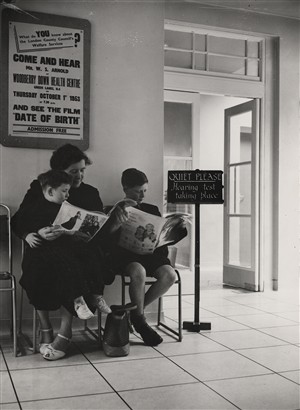Teething problems

© City of London/London Metropolitan Archives
1952-55
By Virginia Smith
Once opened, the job of equipping and staffing it fell to the new LCC Minister of Health, Dr John Scott, who had been Daley’s deputy. New families were still settling into unfamiliar surroundings with parts of the estate still be completed, It was also at the centre of a large Jewish population, where large families were the norm. LCC records show John Scott and the new centre manager patiently solving every problem, from furniture to wages, as the different departments moved in. The lecture hall was put to use immediately.
The 1953 Ministry of Health Report stated that the local authority services were working satisfactorily with “steady development having regard to the weather and the prevalence of infectious illness”. A mass radiography unit had visited, also the blood donor service, and vaccination and antenatal clinics had started. A Mother’s Club had been set up; there were sewing classes on Wednesday afternoons and cooking classes on Monday afternoons; and ‘clean food’ lectures conducted by the Metropolitan Borough of Stoke Newington. Recollecting these early years, some people found the building strange, and at times off-putting – probably because they were used to going to shabby surgeries located in the doctor’s front room at home. Others – particularly mothers and children – evidently spent a lot of time in them.
But the Estate was not finished and the doctors were concerned: “when are the general practitioner services arriving? A large portion of the building is not yet brought into use”. For the local GPs it was a steep learning curve with most of them used to being single-handed doctors – working on their own and literally doing everything themselves, with perhaps the help of one young assistant ‘with a view’. Local doctors joined the new Health Centre largely because they were afraid that other applicants would create rival practices to their own. Far from working together, in the first year the GPs apparently rarely used the common room, or the operating theatre and other facilities. Only two of the six doctors kept open their old surgeries, and saw the majority of their patients there. There was a particular dislike of the local authority’s role in appointing all reception and nursing staff, resulting in constant re-negotiation of ground rents for the common areas.
But it was not an unsociable place to work, as photos of the common room show. For other doctors from out of the area, particularly women doctors, the communal facilities were very convenient, and indeed helped support and develop their practices. In fact the Centre later had more women than male doctors, and consistently found it difficult to attract male doctors. Some of the original doctors stayed for a very long time – Dr Hannah Beerman was one, and she remained there until she died in 1994. Also the original local doctor for the Jewish community, Dr Norman Kass, one of whose assistants was Dr Joseph Spitzer was there from 19XX. Certainly in the early days, as Dr Patel and others recall, the relatively small numbers of staff made it easier to discuss common problems, or organise Christmas dinners.
Nevertheless, the reluctance of individual doctors to join local authority-run health centres was repeated everywhere throughout the UK. Moreover, large purpose-built centres were expensive to build, and so became unaffordable at the time. In 1953 the government decided to abandon the Woodberry Down model, by offering interest-free loans for groups of doctors to build their own privately run ‘centres’, and to start group practices. The encouragement of group practice continued as government policy for the rest of the century. By 1967, 756 group practice health centres had been built in the UK, usually on a modest scale. Other health centres operating in Hackney since the 1950s included Lower Clapton, Upper Clapton, Barton House, and Wick Heath. The health centre movement was not dead – but it had gone in a different direction.
This page was added by
Lisa Rigg on 15/09/2009.